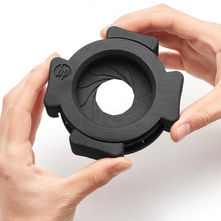HP Polypropylene (PP)
HP Multi Jet Fusion
HP Polypropylene is ideal for producing chemically resistant functional parts with low moisture absorbtion. This versatile material is ideal for piping or fluid systems and containers, and is used in a wide variety of automotive, industrial, consumer goods and medical applications.
3D printing technology
Dimensional accuracy
+/- 0.3% with a lower limit of +/- 0.3 mm
Maximum build size
380 x 285 x 380 mm (14.9" x 11.2" x 14.9")

About HP Polypropylene (PP)
Polypropylene (PP) is one of the most widely used injection molded materials in the world, but it has only recently become available as a viable 3D printing option. Polypropylene is commonly used in applications that require excellent chemical resistance combined with low moisture absorbtion, great flexibility and impact resistance. Amongst commercial plastics, PP has a very low density, allowing for the production of lightweight parts. Automotive, consumer goods, industrial and medical are key sectors that heavily use PP already. Living hinges and watertight applications are good fits for the material, as well as applications requiring electrical resistance.
Key Benefits
-
Strong, high-density parts with near-isometric properties on x-y and z axes
-
Functional parts with fine detail and dimensional accuracy
-
Excellent chemical resistance to oils, greases, alphalitic hydrocarbons, and alkalies
-
Water- and air-tight without further treatment
-
UV resistant
-
Low moisture absorbtion
-
Low cost per part
Applications
-
Functional prototyping and small- to medium-run manufacturing
-
Complex assemblies
-
Car interior parts
-
Fluid and HVAC systems
-
Tubes, pipes, reservoirs
-
Medical devices
-
Orthotics
-
Multi-purpose industrial goods
Design guidelines
Max build volume
380 x 284 x 380 mm (15 x 11.2 x 15")
Min wall thickness
2 mm
Min clearance
0.6 mm
Min slit between walls
0.6 mm
Min hole diameter at 1 mm thickness
0.6 mm
Min printable details
0.3 mm
Min emboss / deboss
0.6 mm
Min depth/height for emboss/deboss
1 mm
Min font
9 pt (3.2 mm)
Design considerations
-
Consider hollowing or adding internal lattice structure to large solid pieces to improve accuracy and minimize cost.
-
See full design guidelines for additional considerations, including clearance, functional assemblies, interlocking parts, hollowing and lattice structures, ducts, threads, how to minimize the risk of warpage, bonding parts, and more.
-
Hinges, sockets, and linked parts can be integrated into the design.
Technical Specifications
Accuracy
+/- 0.7% (minimum of +/- 0.3 mm)
Layer thickness
0.08 mm
Density of parts
0.89 g/cm3
Tensile modulus
1600 MPa (XY), 1600 MPa (Z)
Tensile strength
30 MPa (XY), 30 MPa (Z)
Elongation at break
20% (XY), 18% (Z)
Melting point
187 C
Certifications & Data Sheets
-
Summary of regulatory compliance and environmental attributes
-
Certifications: 9 REACH, RoHS, PAHs, ISO 10993 and US FDA Intact Skin Surface Devices Statements










.jpg)